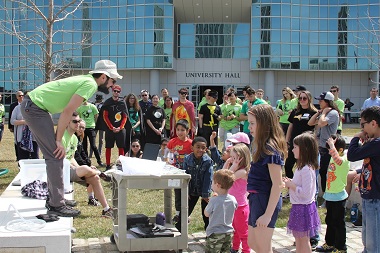5 Questions with Faculty: Earth Day Edition

ALBANY, N.Y. (April 22, 2021) – Today marks the annual tradition known as “Earth Day,” a global movement to demonstrate the importance of environmental protection. This year’s celebration could not be timelier with increasingly extreme weather events such as wildfires and hurricanes continuing to make headlines in the midst of a deadly pandemic.
We caught up with Justin Minder, associate professor in the Department of Atmospheric and Environmental Sciences, to learn more about the significance of this celebration and how the campus community can do its part to help.
Minder has taught at UAlbany for close to a decade and co-leads UAlbany’s Weather, Climate & Chemistry annual summer day camp for teens in the Capital Region.
What is Earth Day and how is it celebrated?
Earth Day is an annual event that takes place around the world on April 22. It began in 1970 as an initiative to increase awareness of important environmental issues. There is no single way that it is celebrated, but common forms of observance include events focused on environmental education, political advocacy around environmental issues, and service projects focused on restoring the environment or improving sustainability.
Why is this celebration so important?

For me, as an educator and a parent of two young kids, I particularly value Earth Day as an opportunity for teaching and learning. There are endless fascinating things to learn about how the Earth and its environment work. I always get excited to learn more and to share my knowledge and passion about Earth science with others.
There’s a range of pressing environmental issues that affect all of us. A key step to solving these issues is to increase awareness and understanding so that people understand how these issues affect things they care about and what the potential solutions are. Prior to the pandemic, I had greatly enjoyed participating in UAlbany’s annual Family Earth Day event, sharing my passion for atmospheric science through demonstrations and bringing my kids to participate in the many fun activities. We look forward to restarting this event when public health conditions allow it.
Can you tell us more about the UAlbany Weather, Climate & Chemistry Camp?
The University at Albany Weather, Climate & Chemistry Camp is an annual summer day camp for teens from the Capital District that takes place in August. It is designed as an interactive experience where students learn about the science of weather, climate and atmospheric chemistry under the instruction of experts in the field. Students also learn about career opportunities, the college application and financial aid process, and college life. It is organized by Sara Lance of our Atmospheric Sciences Research Center and myself, with help from other UAlbany faculty, staff, graduate students and undergraduate students.
This summer’s camp is funded by grants from the William Gundry Broughton Foundation, Bender Scientific and the National Science Foundation. Our camp brings together many bright and enthusiastic students. I’m proud to say that a number of past campers have returned to campus as undergraduate students, including several who are currently in the Department of Atmospheric and Environmental Sciences.
What are the largest environmental issues facing us today?
The overarching environmental challenge for humanity is one of sustainability: How can humans interact with our environment in such a way that provides all communities with what they need to thrive without seriously degrading the ability of the environment to support the Earth’s ecosystems and future human generations? I’m specifically focused on climate change, partially because of my knowledge on the topic, but also because it has connections to many of the other environmental issues we are facing today. Climate change is something that will increasingly impact everyone. However, as with many environmental issues, the effects will be most acutely felt by poor and marginalized communities, so concepts of “environmental justice” are important as we work to address this problem.
How can members of our campus community reduce their carbon footprint?
There are lots of great ways to reduce our personal carbon footprint. For example, using low-carbon transportation (public transit, bikes, electric cars), increasing the energy efficiency of our homes, limiting air travel, and eating a climate-friendly diet rich in plants. However, individual choices alone, while helpful, are not sufficient to solve climate change. The magnitude of the problem requires large-scale systematic changes in areas such as how society generates energy for electricity and heating, transportation infrastructure, and food production. As such, political engagement may be the most effective means to help. Solving the climate problem may seem daunting, but the necessary changes are also an exciting opportunity to shape a more sustainable, prosperous, livable and equitable society.




